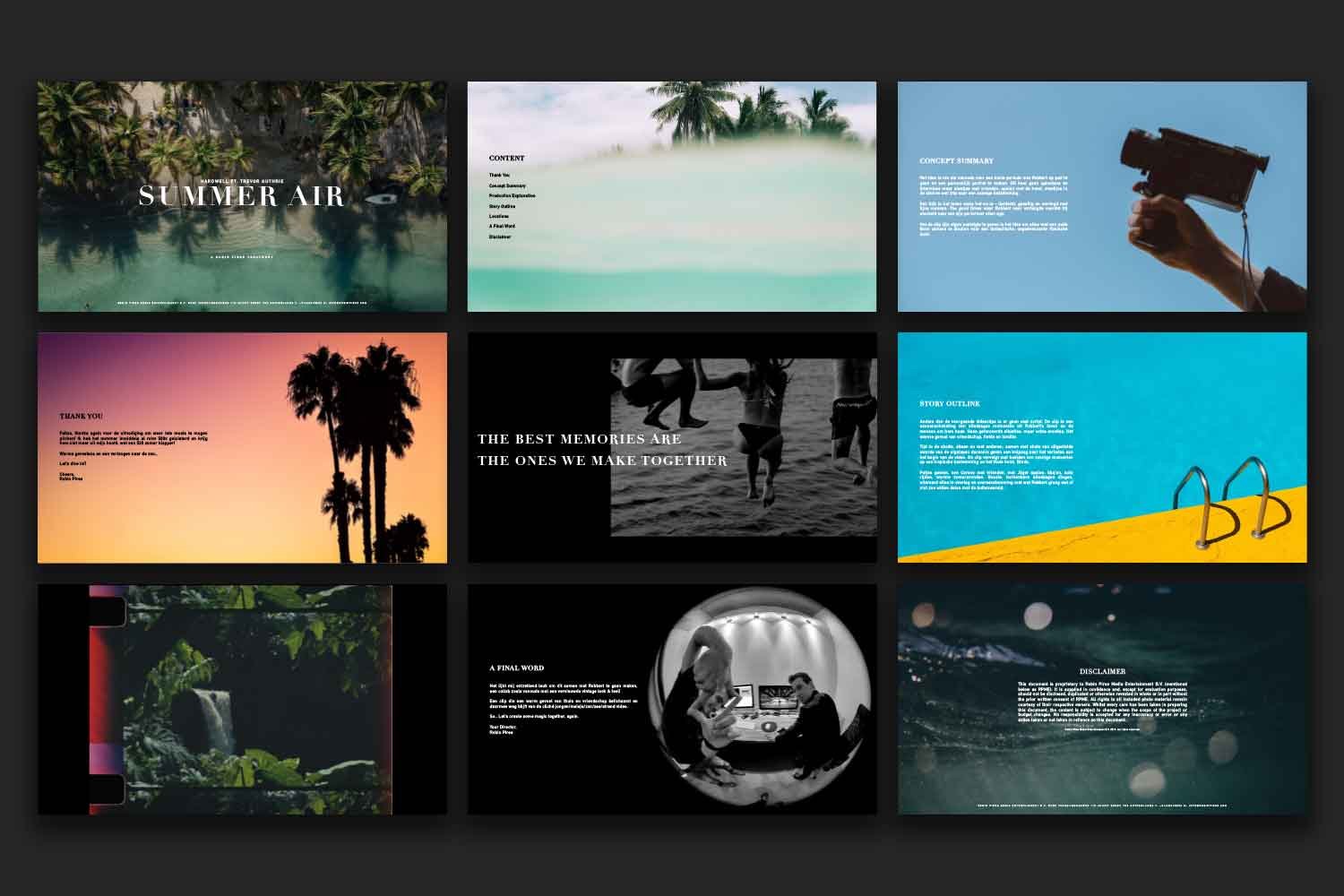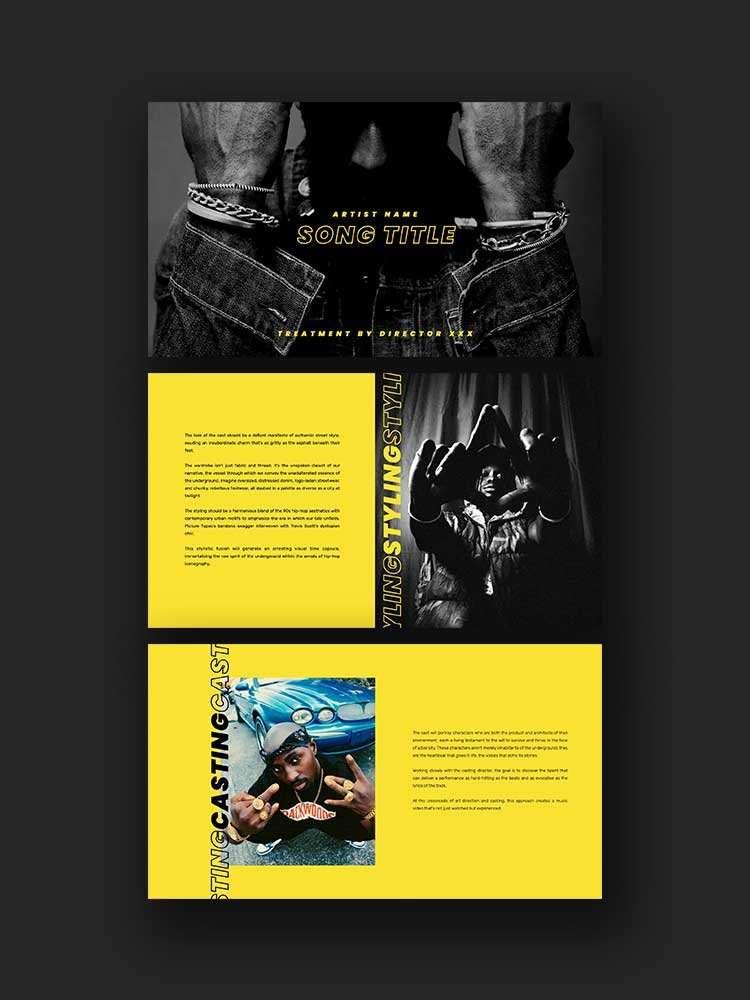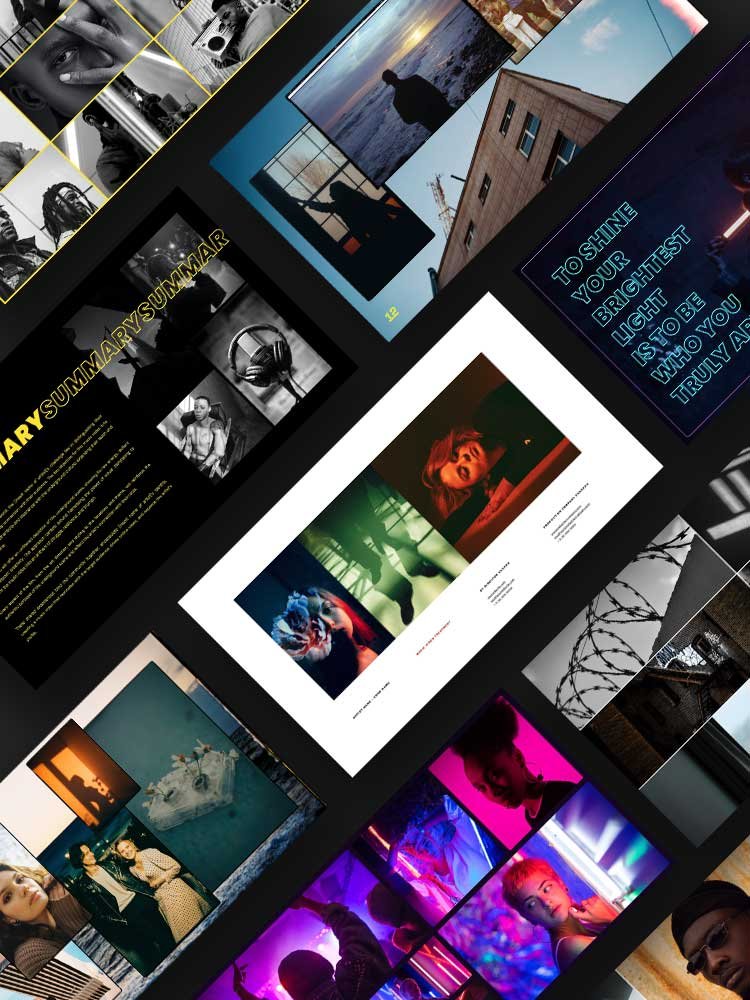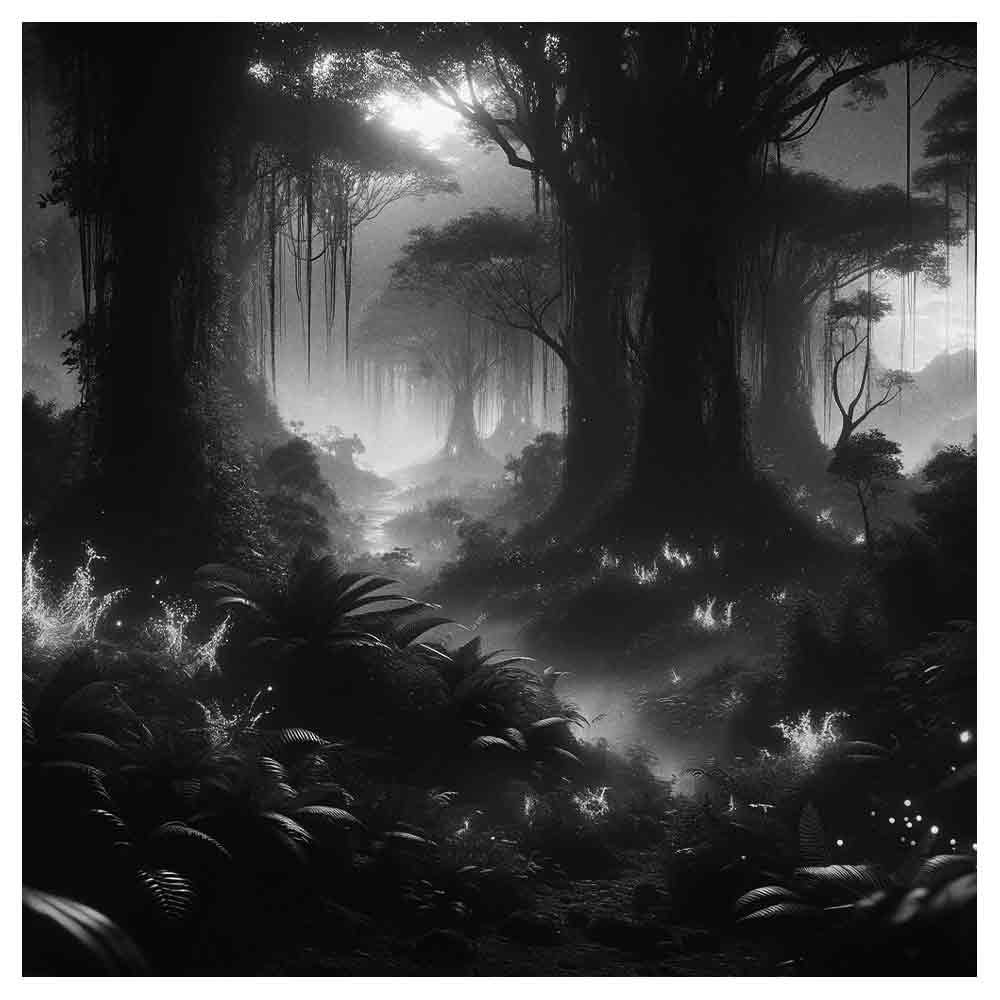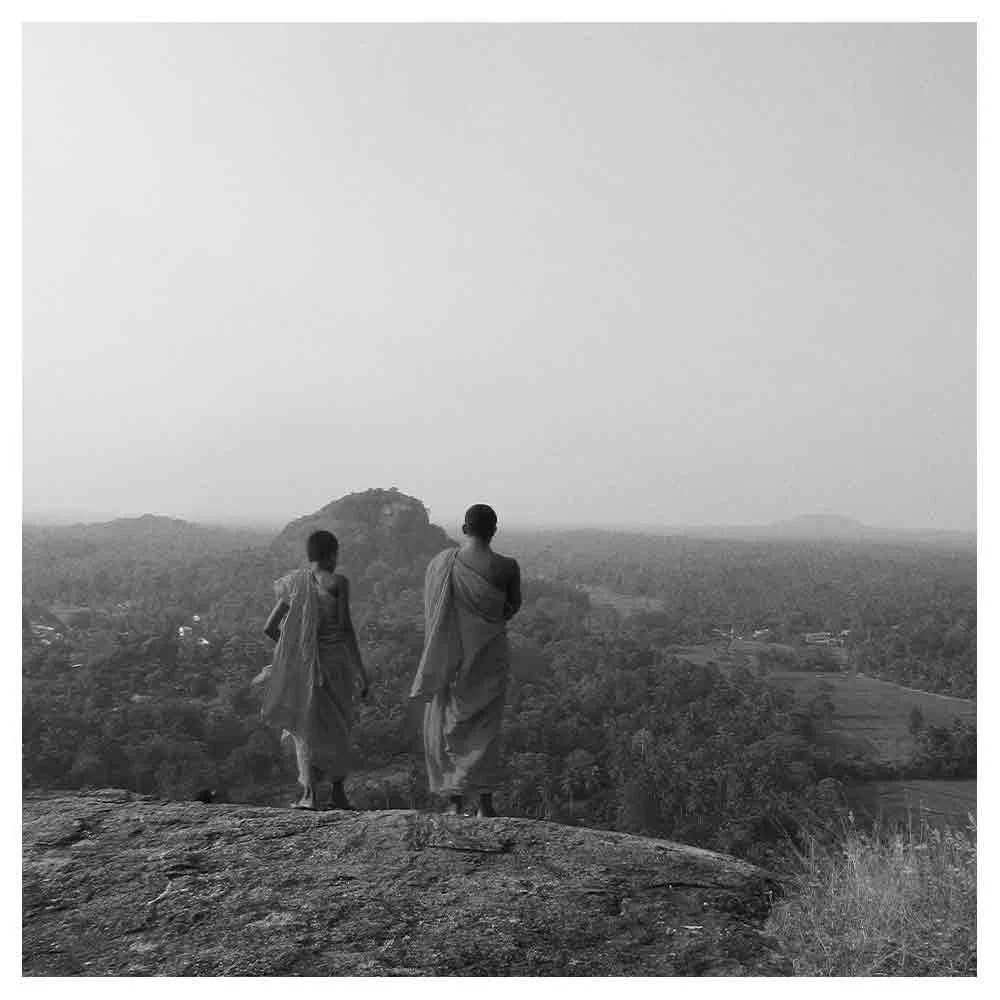What is A Music Video Treatment? The ultimate Guide + Templates
When making a music video for an artist or music label, one of the most important things to get right at the beginning of the process is the music video treatment—sometimes referred to as the director's treatment.
Packed with eye-catching images, these digital pitch documents made by te music video director form the kick-off point for every music video production. They are the industry's entry ticket for landing the gig as a music video director and form a creative guideline for the music video production team.
But what is a music video treatment? Why are music video treatments so important? And how can a good music video treatment help you land your next music video project?
That's what I'll outline in the article below!
What Is A Music Video Treatment?
A music video treatment is a visually appealing digital pitch document with flowery language and images that outline a music video idea, approach, and visual style, according to the music video director.
The purpose of this visual medium is to show the potential client what the final product (the music video) could look like if they decide to work with the music video director who created the treatment.
What is the music video treatment process?
The process of a music video treatment starts with a record label that sends a music video treatment request to several video production companies or freelance music video directors.
After receiving the individual pitch documents, the artist, music label, and management will award the job based on the music video treatment that best aligns with their collaborative vision for the project.
Why Are Music Video Treatments Important?
We must approach pitching creative ideas via these pitch documents from a different perspective to understand why music video treatments are essential to music video productions.
Problems & Solutions
For a long time, I believed people hired me solely because they wanted to make a beautiful film. I now understand that is not how it works.
How it does work in this world is that every successful business exists because it helps solve someone’s problem by selling products or services.
music video problems
In the world of music videos, problem-solving means that someone wants to create a beautiful video for a song but doesn’t have the time, tools, skills, or network to pull it off.
That’s why music artists and record labels, the filmmaking expert, come to me to help them solve that problem. If they had the time, tools, skills, or network to do it themselves, they wouldn’t have had a problem and wouldn’t have contacted me for help.
music video solutions
A music video treatment is my tool to give the artist, manager, and music label a visual understanding, using images and words, of how I can help them solve their problem. It’s how I present my solution and myself as the problem solver.
I now understand that pitching a cool music video idea makes no sense if it doesn’t solve a problem. Without a problem-solving approach, the artist or music label has no value and gain and won’t buy it.
With this problem-solving mindset, pitching ideas, a.k.a solutions, suddenly is no longer about selling but helping others.
What does a music video treatment include?
The next question would be, what should a music video treatment include? The simple answer is that a music video treatment includes a presentation of the solution a client is looking for.
Suppose a client is specifically looking for a detailed production breakdown of an animated music video, and you present a storyboard of a performance music video. In that case, your chances of winning the music video pitch are nihil. Because every business revolves around solving problems, different projects with different goals and challenges will require you to formulate and present different solutions in your music video treatments.
Therefore, there is no universal answer for what a music video treatment should include and what not. These documents have no standard for breaking down the scenes, concept, budget, or script.
Depending on the solution a client is looking for to make a buying decision, you can layer in as many sections or chapters (story, characters, art direction, cinematography, storyboard, locations, etc.) as you like or need in your music video treatment to explain your solution.
If you want to know what to include, ask what they want to see in your music video treatment. Knowing their decision-making criteria, you can tailor your music video treatment to meet those requirements.
understand the Client’s motivation for making a music video
Because music videos are essentially marketing tools for the music, it usually helps to discover the client’s motivation, a.k.a. their business goal of the music video.
Does the label want to show the artist in a specific way to attract a new audience for their music? Does the music artist want to communicate a particular (marketing) message or (political) statement to provoke a response and create hype? Is the artist's management looking for a specific music video as part of a re-branding package?
If you can discover the business goal of the music video, you can use that in your music video treatment to sell your solution, a.k.a. your music video ideas.
Asking lots of questions and client input in the project's discovery phase after you've received the client brief is elementary to that.
I can assure you that if you ask the right questions, you'll get the right answers, and you can formulate the right solutions.
How long is a music video treatment?
When writing treatments, you probably also wonder how long your document should be. As much as I’d like to give you one universal answer to that question, the truth is that there is no such thing as a right or a wrong number of slides.
Some believe it always has to be an X number of slides, but that’s not true. The length depends on how much detail you wish or require to include in your pitch document.
Do you want to hit the sweet spot regarding music video treatment length? Then ask your potential client what they’re looking for and how long they need or prefer the treatment to be to make a decision.
Do they prefer a quick read, or do they require a lot of details about the final video because they will need to pitch this document to their superior? Follow those guidelines if they give explicit instructions to deliver a longer or shorter document.
Conclusion
I have experienced over the years that it all comes down to this: the simpler you can distill and formulate your solution, the more likely people will read and understand it.
If you can make it snappy and engaging while covering all the essential details of a solid solution on one page, then one single page it is.
But if you need 50 slides because the artists and record labels want a detailed description of your video's concept, then 50 slides is the way to go.
Frequently Asked Questions About Music Video Treatments (FAQs)
What is a music video treatment?
A music video treatment is a document that outlines the visual concept of a music video from start to finish.
It includes details about the theme, story, visual style, and production elements to give the production team, record label, and artist a clear vision of the final product.
Why do I need a music video treatment?
Clarity and Vision: Helps everyone involved understand the creative vision and ensures all are on the same page.
Pitching Tool: Essential for presenting your concept to potential clients or music labels to win bids.
Coordination: Facilitates the coordination of visual and thematic elements across various teams (camera, art, wardrobe, etc.).
What should be included in a music video treatment?
Story Synopsis: A brief outline of the narrative or theme of the music video.
Visual Style: Descriptions of the color palette, camera angles, lighting, and special effects.
Mood and Tone: Mood boards and visual references that convey the feel and style of the video.
Production Details: Information on locations, main characters, scenes, props, and wardrobe.
Contact Details: Your contact information for further discussions or clarifications.
How do I start writing a music video treatment?
Listen to the Song: Understand the music's mood, lyrics, and rhythm.
Visual Inspiration: Gather images and videos that inspire you and relate to the song's theme.
Write the Story: Outline the main story beats and how they connect with the song.
Describe the Visuals: Detail the artistic vision, including scenes and visual elements.
Finalize Details: Include practical aspects like budget, locations, and necessary special effects.
Can you give an example of how to describe a scene in a treatment?
Certainly! Here's a simple example using vibrant colors and dynamic camera angles to match the energy of a fast-paced track:
Scene Description: "The scene opens on an empty chair in a dimly lit room. As the chorus hits, a burst of colorful background lighting illuminates the artist from behind, creating a visually appealing halo effect. The camera circles the artist in slow motion capturing the raw emotion and energy of the performance."
What are some pro tips for making my treatment stand out?
Be Concise but Descriptive: Use bullet points and short paragraphs to convey your ideas clearly and vividly.
Use Visual References: Include mood boards, past videos, or storyboard elements to visually communicate your ideas.
Keep the Reader in Mind: Write in an engaging, active voice and present tense to keep the reader's attention.
Avoid Flowery Language: Be straightforward to ensure your creative ideas are easy to understand.
How detailed should the treatment be?
The details of your treatment can vary depending on the audience. If you're pitching to experienced filmmakers or a music video director, they might appreciate a more detailed document that includes scene breakdowns and technical specifications.
For a record label or artist, keep the treatment focused on the story and visual appeal to capture their interest without overwhelming them.
What's the common mistake to avoid in music video treatments?
Avoid overloading the treatment with too much text or too many technical details that might detract from the main creative ideas.
Instead, focus on making the document visually engaging and easy to read, with clear sections and attention-grabbing fonts.
How do I use feedback to improve my treatment?
Review and Refine: Incorporate feedback from collaborators or potential clients to tweak your treatment.
Stay Flexible: Be open to changing certain elements to better suit the needs of the project or the vision of the artist.
Iterate: Sometimes, the best way to perfect your treatment is through multiple iterations. Don't be afraid to rewrite sections based on the input you receive.
Final thoughts on music video treatments?
Writing a compelling music video treatment is both an art and a science. It combines creative storytelling with practical filmmaking logistics.
The best treatments are those that can not only sell a vision but also guide the entire production team through the creative process efficiently.
Remember, a great treatment is your first step towards creating a memorable music video, so invest the time to make it impactful!
